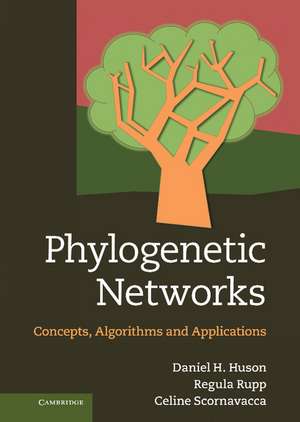Phylogenetic Networks: Concepts, Algorithms and Applications
Autor Daniel H. Huson, Regula Rupp, Celine Scornavaccaen Limba Engleză Hardback – dec 2010
Preț: 489.99 lei
Preț vechi: 550.56 lei
-11% Nou
Puncte Express: 735
Preț estimativ în valută:
93.79€ • 101.91$ • 78.83£
93.79€ • 101.91$ • 78.83£
Carte tipărită la comandă
Livrare economică 21 aprilie-05 mai
Preluare comenzi: 021 569.72.76
Specificații
ISBN-13: 9780521755962
ISBN-10: 0521755964
Pagini: 376
Ilustrații: 189 b/w illus. 80 exercises
Dimensiuni: 179 x 253 x 20 mm
Greutate: 0.88 kg
Editura: Cambridge University Press
Colecția Cambridge University Press
Locul publicării:Cambridge, United Kingdom
ISBN-10: 0521755964
Pagini: 376
Ilustrații: 189 b/w illus. 80 exercises
Dimensiuni: 179 x 253 x 20 mm
Greutate: 0.88 kg
Editura: Cambridge University Press
Colecția Cambridge University Press
Locul publicării:Cambridge, United Kingdom
Cuprins
Part I. Introduction: 1. Basics; 2. Sequence alignment; 3. Phylogenetic trees; 4. Phylogenetic networks; Part II. Theory: 5. Clusters and rooted phylogenetic networks; 6. Splits and unrooted phylogenetic networks; Part III. Algorithms and Applications: 7. Phylogenetic networks from clusters; 8. Phylogenetic networks from splits; 9. Phylogenetic networks from sequences; 10. Phylogenetic networks from distances; 11. Phylogenetic networks from trees; 12. Phylogenetic networks from triplets or quartets; 13. Drawing phylogenetic networks; 14. Software; Glossary; Index.
Recenzii
'Networks - rather than just trees - are fast becoming the essential tool for making sense of the complexities of evolution and conflicting signal[s] in genomic data. Phylogenetic Networks provides a long-overdue exposition of network-based methods, their possible uses and details on practical software. A detailed and unified treatment of the many different types of networks is complemented by a crisp synopsis of the underlying theory. Numerous example[s] and illustrations make the text easy to follow. This book will further transform the way biologists use genomic data to study evolution. The Tübingen group has led the development of phylogenetic network algorithms, and this book delivers a clear exposition for biologists bewildered by a plethora of recent methods, as well as for bioinformaticians aiming to develop the field further. It is essential reading for any scientist or student seeking to understand how genomic data can be used to represent and study the intricate 'web of life'.' Mike Steel, University of Canterbury
'This textbook, by one of the leaders of the field (Daniel H. Huson) and his co-authors, provides a mathematically rigorous introduction to one of the most exciting and beautiful research areas in computational biology: phylogenetic networks. The text is clear and provides all the necessary biology background; it should be accessible to graduate students (or upper-division undergraduates) in mathematics, computer science or statistics.' Tandy Warnow, University of Texas
'This wonderfully accessible book is by far the most thorough and up-to-date treatment of phylogenetic networks about. Many evolutionary processes in nature do not conform to the simple model of phylogenetic trees; examples are hybridizations, symbioses, and lateral gene transfer. The more we probe nature with genomics, the more significant and numerous these examples become, so there is a real need for using networks in phylogenetics. This volume is a must for researchers working with phylogenetic networks. It is for an advanced college audience. Beautifully organized and clearly written, it really fills a void.' Bill Martin, University of Düsseldorf
'… a brave and ambitious attempt to describe the field of phylogenetic networks anno 2012 from a motivated algorithmic perspective … a formidable achievement … It will deservedly become essential reading for both mathematically inclined researchers already working in the field and those looking for an easy way to enter the field. … an important milestone in the development of the field.' Systematic Biology
'This textbook, by one of the leaders of the field (Daniel H. Huson) and his co-authors, provides a mathematically rigorous introduction to one of the most exciting and beautiful research areas in computational biology: phylogenetic networks. The text is clear and provides all the necessary biology background; it should be accessible to graduate students (or upper-division undergraduates) in mathematics, computer science or statistics.' Tandy Warnow, University of Texas
'This wonderfully accessible book is by far the most thorough and up-to-date treatment of phylogenetic networks about. Many evolutionary processes in nature do not conform to the simple model of phylogenetic trees; examples are hybridizations, symbioses, and lateral gene transfer. The more we probe nature with genomics, the more significant and numerous these examples become, so there is a real need for using networks in phylogenetics. This volume is a must for researchers working with phylogenetic networks. It is for an advanced college audience. Beautifully organized and clearly written, it really fills a void.' Bill Martin, University of Düsseldorf
'… a brave and ambitious attempt to describe the field of phylogenetic networks anno 2012 from a motivated algorithmic perspective … a formidable achievement … It will deservedly become essential reading for both mathematically inclined researchers already working in the field and those looking for an easy way to enter the field. … an important milestone in the development of the field.' Systematic Biology
Notă biografică
Descriere
First interdisciplinary overview of phylogenetic networks, covering biological background, the underlying mathematics, the computational algorithms and the software available.











